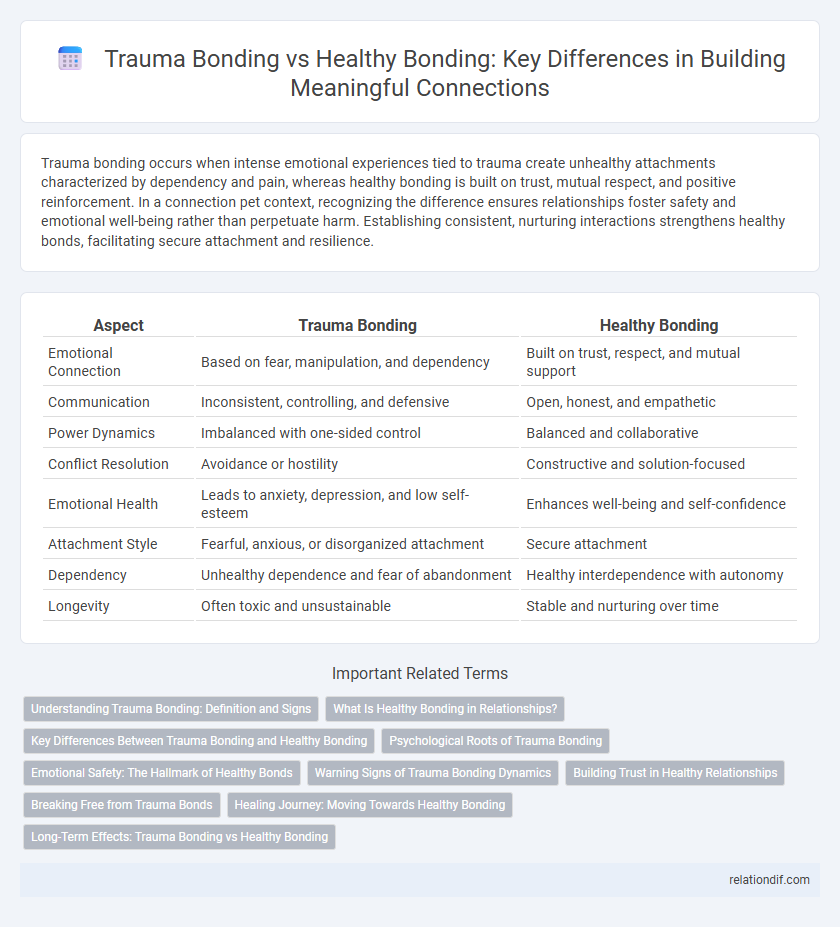Trauma bonding occurs when intense emotional experiences tied to trauma create unhealthy attachments characterized by dependency and pain, whereas healthy bonding is built on trust, mutual respect, and positive reinforcement. In a connection pet context, recognizing the difference ensures relationships foster safety and emotional well-being rather than perpetuate harm. Establishing consistent, nurturing interactions strengthens healthy bonds, facilitating secure attachment and resilience.
Table of Comparison
| Aspect | Trauma Bonding | Healthy Bonding |
|---|---|---|
| Emotional Connection | Based on fear, manipulation, and dependency | Built on trust, respect, and mutual support |
| Communication | Inconsistent, controlling, and defensive | Open, honest, and empathetic |
| Power Dynamics | Imbalanced with one-sided control | Balanced and collaborative |
| Conflict Resolution | Avoidance or hostility | Constructive and solution-focused |
| Emotional Health | Leads to anxiety, depression, and low self-esteem | Enhances well-being and self-confidence |
| Attachment Style | Fearful, anxious, or disorganized attachment | Secure attachment |
| Dependency | Unhealthy dependence and fear of abandonment | Healthy interdependence with autonomy |
| Longevity | Often toxic and unsustainable | Stable and nurturing over time |
Understanding Trauma Bonding: Definition and Signs
Trauma bonding occurs when intense emotional connections develop through cycles of abuse, manipulation, and intermittent positive reinforcement, often causing individuals to feel trapped in toxic relationships despite harm. Signs of trauma bonding include cognitive dissonance, where victims justify or minimize abuse, heightened emotional dependence, and a persistent fear of abandonment despite mistreatment. Recognizing these patterns is crucial for distinguishing unhealthy attachments from healthy bonds that are based on mutual respect, trust, and emotional safety.
What Is Healthy Bonding in Relationships?
Healthy bonding in relationships involves mutual trust, open communication, and emotional safety, allowing both partners to express vulnerabilities without fear of judgment. It fosters secure attachment where individuals feel valued, respected, and supported, promoting personal growth and resilience. This type of connection contrasts with trauma bonding by emphasizing stability and positive reinforcement instead of fear, manipulation, or dependency.
Key Differences Between Trauma Bonding and Healthy Bonding
Trauma bonding is characterized by cycles of abuse and reconciliation, where emotional attachment is fueled by fear, manipulation, and intermittent reinforcement, leading to unhealthy dependency. Healthy bonding, in contrast, is built on trust, mutual respect, consistent support, and secure emotional connection, promoting psychological well-being. Key differences include the dynamics of power imbalance and emotional safety, where trauma bonds involve coercion and unpredictability, whereas healthy bonds foster stability and genuine care.
Psychological Roots of Trauma Bonding
Trauma bonding stems from intermittent reinforcement of abuse and affection, creating a powerful emotional attachment rooted in fear, survival, and dependency. The psychological roots lie in the brain's altered stress response system, where oxytocin and cortisol interact to entrench loyalty despite harm. Understanding these mechanisms highlights the stark contrast with healthy bonding, which is based on consistent safety, trust, and mutual respect rather than trauma-induced cycles.
Emotional Safety: The Hallmark of Healthy Bonds
Emotional safety is the hallmark of healthy bonds, fostering trust, vulnerability, and mutual respect between individuals. Trauma bonding often involves cycles of abuse and reconciliation, which undermine emotional security and create dependency. In contrast, healthy bonding nurtures consistent emotional support and open communication, essential for long-term relational resilience.
Warning Signs of Trauma Bonding Dynamics
Warning signs of trauma bonding dynamics include intense emotional dependency despite consistent mistreatment, cycles of abuse followed by reconciliation, and a distorted sense of loyalty to the abuser. Individuals caught in trauma bonds often experience confusion, low self-esteem, and isolation from supportive networks, which impede recognizing healthy boundaries. Awareness of these red flags is crucial for breaking free and fostering healthy, secure connections rooted in mutual respect and trust.
Building Trust in Healthy Relationships
Building trust in healthy relationships involves consistent communication, mutual respect, and emotional safety, which contrasts sharply with trauma bonding's cycle of fear and dependency. Trust develops over time through transparency and reliable behavior, fostering a secure attachment that supports vulnerability and growth. Establishing boundaries and recognizing each partner's needs are essential components for cultivating a stable and nurturing connection.
Breaking Free from Trauma Bonds
Breaking free from trauma bonds requires recognizing patterns of manipulation, emotional abuse, and attachment rooted in pain. Healthy bonding fosters trust, safety, and mutual respect, contrasting with trauma bonds that often involve cycles of conflict and reconciliation. Strengthening self-awareness and seeking supportive relationships are crucial steps to disrupt unhealthy attachments and build empowering connections.
Healing Journey: Moving Towards Healthy Bonding
Healing from trauma bonding requires recognizing patterns of emotional manipulation and establishing boundaries that foster trust and self-respect. Cultivating healthy bonding involves consistent communication, empathy, and mutual support that repairs emotional wounds and promotes psychological resilience. Embracing therapeutic interventions like trauma-informed counseling accelerates recovery and strengthens secure attachments.
Long-Term Effects: Trauma Bonding vs Healthy Bonding
Trauma bonding often results in prolonged emotional distress, impaired trust, and difficulty forming secure attachments, which can perpetuate cycles of abuse and instability in relationships. Healthy bonding fosters long-term emotional security, resilience, and mutual respect, promoting psychological well-being and stable interpersonal connections. Research highlights that secure attachments correlate with improved mental health outcomes, while trauma bonds increase the risk of anxiety, depression, and relational dysfunction over time.
Trauma Bonding vs Healthy Bonding Infographic

 relationdif.com
relationdif.com